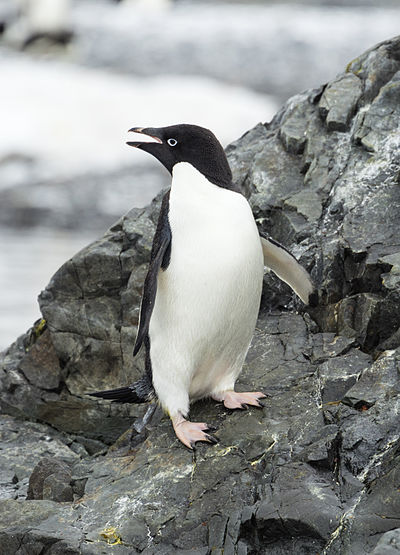Adélie penguin
| Adélie penguin | |
|---|---|
|
|
|
| Hope Bay, Antarctica | |
| Scientific classification | |
| Kingdom: | Animalia |
| Phylum: | Chordata |
| Class: | Aves |
| Order: | Sphenisciformes |
| Family: | Spheniscidae |
| Genus: | Pygoscelis |
| Binomial name | |
|
Pygoscelis adeliae (Hombron & Jacquinot, 1841) |
|
The Adélie penguin (Pygoscelis adeliae) is a species of penguin common along the entire Antarctic coast, which is their only residence. They are among the most southerly distributed of all seabirds, along with the emperor penguin, the south polar skua, the Wilson's storm petrel, the snow petrel, and the Antarctic petrel. They are named after Adélie Land, in turn named for Adèle Dumont D'Urville, the wife of French explorer Jules Dumont d'Urville who discovered these penguins in 1840.
The Adélie penguin is one of three species in the genus Pygoscelis. and nuclear DNA evidence suggests the genus split from other penguins around 38 million years ago, about 2 million years after the ancestors of the genus Aptenodytes. In turn, the Adélie penguins split off from the other members of the genus around 19 million years ago.
Based on a 2014 analysis of fresh guano-discolored coastal areas, 3.79 million breeding pairs of Adélie penguins are in 251 breeding colonies [1], a 53% increase over a census completed 20 years earlier. The colonies are distributed around the coastline of the Antarctic land and ocean. Colonies have declined on the Antarctic Peninsula, but those declines have been more than offset by increases in East Antarctica. During the breeding season, they congregate in large breeding colonies, some over a quarter of a million pairs. Individual colonies can vary dramatically in size, and some may be particularly vulnerable to climate fluctuations.
Adélie penguins breed from October to February on shores around the Antarctic continent. Adélies build rough nests of stones. Two eggs are laid, these are incubated for 32 to 34 days by the parents taking turns (shifts typically last for 12 days). The chicks remain in the nest for 22 days before joining crèches. The chicks moult into their juvenile plumage and go out to sea after 50 to 60 days.
...
Wikipedia


